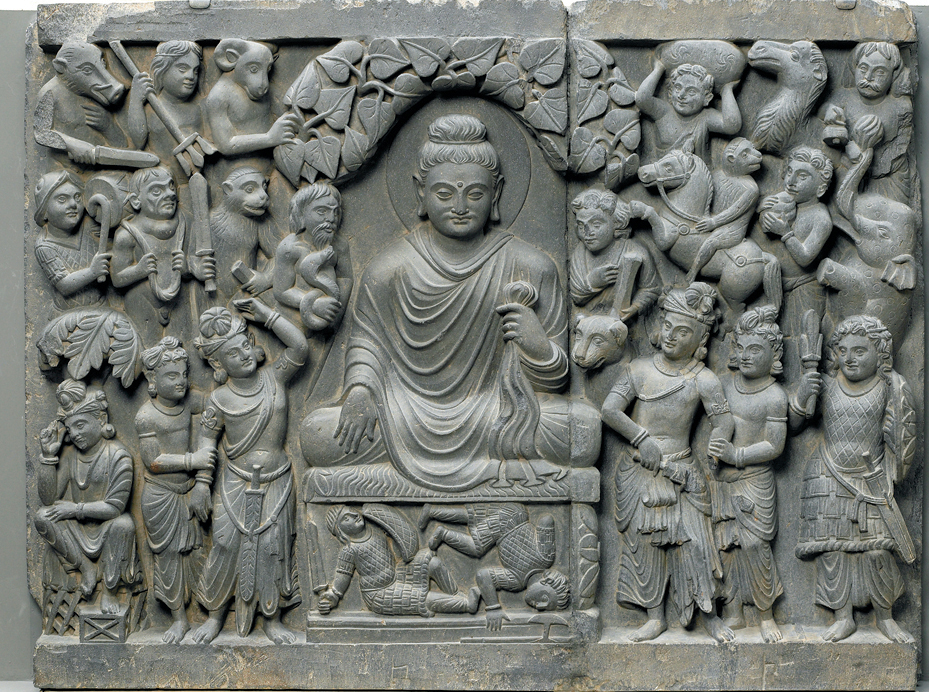A History of World Societies:
Printed Page 75
A History of World Societies Value
Edition: Printed Page 70
Siddhartha Gautama and Buddhism
Siddhartha Gautama (fl. ca. 500 B.C.E.), also called Shakyamuni (“sage of the Shakya tribe”), is best known as the Buddha (“enlightened one”). He was a contemporary of Mahavira and came from the same warrior social class. He was born the son of a chief of one of the tribes in the Himalayan foothills in what is now Nepal. At age twenty-

In his first sermon the Buddha outlined his main message, summed up in the Four Noble Truths and the Eightfold Path. The Four Noble Truths are as follows: (1) pain and suffering, frustration, and anxiety are ugly but inescapable parts of human life; (2) suffering and anxiety are caused by human desires and attachments; (3) people can understand these weaknesses and triumph over them; and (4) this triumph is made possible by following a simple code of conduct, the Eightfold Path. The basic insight of Buddhism is thus psychological. The deepest human longings can never be satisfied, and even those things that seem to give pleasure cause anxiety because we are afraid of losing them. Attachment to people and things causes sorrow at their loss.
The Buddha offered an optimistic message in that all people can set out on the Eightfold Path toward liberation. All they have to do is take a series of steps, beginning with recognizing the universality of suffering (“right knowledge”), deciding to free themselves from it (“right purpose”), and then choosing “right conduct” (including abstaining from taking life), “right speech,” “right livelihood,” and “right endeavor.” The seventh step is “right awareness,” constant contemplation of one’s deeds and words, giving full thought to their importance and whether they lead to enlightenment. “Right contemplation,” the last step, entails deep meditation on the impermanence of everything in the world. Those who achieve liberation are freed from the cycle of birth and death and enter the state called nirvana, a kind of blissful nothingness and freedom from reincarnation.
Buddhism differed from Brahmanism and later Hinduism in that it ignored the caste system. Everyone, noble and peasant, educated and ignorant, male and female, could follow the Eightfold Path. Moreover, the Buddha was extraordinarily nondogmatic. Convinced that each person must achieve enlightenment on his or her own, he emphasized that the path was important only because it led the traveler to enlightenment, not for its own sake. He compared it to a raft, essential to cross a river but useless once the traveler reaches the far shore. There was no harm in honoring local gods or observing traditional ceremonies, as long as one remembered the goal of enlightenment and did not let sacrifices become snares or attachments. The willingness of Buddhists to tolerate a wide variety of practices aided the spread of the religion.
Like Mahavira, the Buddha formed a circle of disciples, primarily men but including some women as well. He continually reminded them that each person must reach ultimate fulfillment by individual effort, but he also recognized the value of a group of people striving together for the same goal.
The Buddha’s followers transmitted his teachings orally until they were written down in the second or first century B.C.E. These scriptures are called sutras. The form of monasticism that developed among the Buddhists was less strict than that of the Jains. Buddhist monks moved about for eight months of the year (except the rainy season), begging for their one meal a day, but they could bathe and wear clothes. Within a few centuries Buddhist monks began to overlook the rule that they should travel. They set up permanent monasteries, generally on land donated by kings or other patrons. Orders of nuns also appeared, giving women the opportunity to seek truth in ways men had traditionally used. The main ritual that monks and nuns performed in their monastic establishments was the communal recitation of the sutras. Lay Buddhists could aid the spread of the Buddhist teachings by providing food for monks and support for their monasteries, and they could pursue their own spiritual progress by adopting practices such as abstaining from meat and alcohol. (See “Individuals in Society: Sudatta, Lay Follower of the Buddha.”)
Because Buddhism had no central ecclesiastical authority like the Christian papacy, early Buddhist communities developed several divergent traditions and came to stress different sutras. One of the most important of these, associated with the monk-
Just as important as the metaphysical literature of Mahayana Buddhism was its devotional side, influenced by the religions then prevalent in Central Asia, such as Zoroastrianism (see “The Religion of Zoroaster” in Chapter 2). The Buddha became deified and was placed at the head of an expanding pantheon of other Buddhas and bodhisattvas (boh-
Buddhism remained an important religion in India until about 1200 C.E. By that time it had spread widely through East, Central, and Southeast Asia. After 1200 C.E. Buddhism declined in India, losing out to both Hinduism and Islam, and the number of Buddhists in India today is small. Buddhism never lost its hold in Nepal and Sri Lanka, however, and today it is also a major religion in Southeast Asia, Tibet, China, Korea, and Japan.